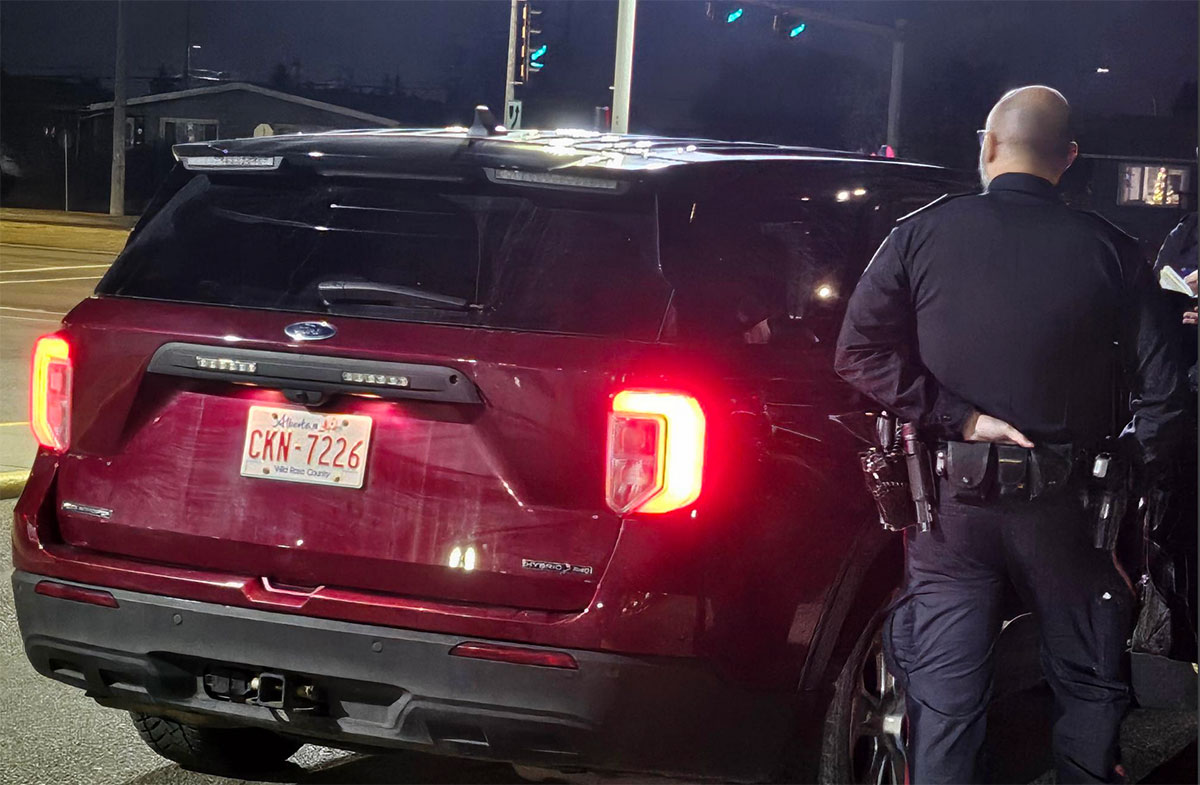The Edmonton Police Service’s defensive response to a recent case in which an officer tackled and injured an innocent teenage girl exemplifies why public trust in police is being eroded under Chief Dale McFee, according to both a prominent criminal defence lawyer and a criminologist.
Police in north Edmonton recently detained 17-year-old Haylie Nahamko-White because of what a police news release claimed was a case of mistaken identity.
McFee, however, blamed the arrest on the teenager.
“When police ask you to stop more than one time, you know, it’s really against the law to run,” the police chief told Global News Edmonton, which first reported the incident.
“So I think we have to look at this and we obviously have to figure out if something did go wrong, what went wrong.”
Edmonton lawyer Tom Engel and University of Alberta criminologist Temitope Oriola say McFee’s defence of the arrest and his prejudgment of the case follow a troubling pattern of obfuscation and lack of accountability for a police force with a controversial history of using force.
“It’s constant, it’s systemic and it's become much worse under McFee’s command,” said Engel, whose law firm has represented hundreds of clients in brutality complaints against police over more than three decades.
“McFee has gone back to the old days of former chief Mike Wasylyshen, which was all about the misguided approach of protecting the reputation of the police service.”
McFee declined a detailed interview request from The Tyee.
Police said they were en route to a domestic dispute in which a woman had refused to leave a house, and Nahamko-White fit the description they had been given.
The Tyee made a formal request for the description and the reasons police apprehended Nahamko-White in the street given the information a woman was refusing to leave a house.
In response, a police spokesperson said the information wouldn’t be provided because the matter was under investigation by the EPS Professional Standards Branch. The spokesperson didn’t explain why the police justification of mistaken identity could be released but this information couldn’t.
Engel, who recently has been retained by Charlene Nahamko, Haylie’s mother, said the information sought by The Tyee couldn’t affect the internal investigation because it is already known by the officers who are the subject of the investigation.
Engel said the logical inference to draw from the police refusal to release the suspect’s description is that it doesn’t match Haylie’s description.
A Tyee reporter went to the scene this week and knocked on the door of a house that directly faced the spot where police tackled Haylie.
A woman said she had not witnessed the takedown but had seen media coverage of it.
She said police, in unmarked SUVs, had been to the house next door at least three times in the past year. And she said the house’s owner had a daughter who was of Asian descent, petite, who sometimes dyed her hair blond and was in her mid-20s but could pass for a teenager.
“[Police] could have thought it was her, if they were specifically looking for her,” said the neighbour, who requested anonymity.
At the neighbour’s house, a middle-aged Asian woman who answered the door spoke no English.
On Nov. 13, around 10:30 p.m., Haylie was talking on the phone with her boyfriend as she walked toward a north Edmonton mall where he was parked, waiting to give her a ride home after her shift as a lifeguard.
An unmarked burgundy-coloured SUV pulled up beside her with two men inside. It did not turn on its flashing lights, which would have immediately signalled it was a police vehicle.

It was overcast, dark, with little ambient light to illuminate the SUV’s interior. She thought at first they needed directions — this is a critical point — so she pulled back her hoodie and removed one of her earbuds so she could hear them.
At five foot two and 120 pounds, with her hoodie pulled back, the officer should have seen she was a petite, fresh-faced teenager, with blond hair, braces and a nose stud. She also was carrying a backpack emblazoned with the emblem of Vimy Ridge Academy, her high school.
The black hoodie and black track pants she was wearing are the common uniform of millions of young people in North America and Europe; nothing about her clothing was extraordinary.
One officer told her they were police but what Haylie saw was an unmarked SUV, one man wearing a toque and two guys wearing dark clothes with no visible reflective police markings or badges.
“They told her that if she ran, they would Taser her,” Charlene told The Tyee.
Believing she might be the target of an attempted kidnapping, Haylie panicked and fled into traffic. She believed it would be better to get hit by a car than to be captured and sex trafficked.
An officer tackled her to the pavement, scraping her lips and face. She is still awaiting the results of an X-ray to see if she has a broken tailbone.
The terrified teenager fought with the officer as he attempted to handcuff her. She said it wasn’t until she was in the back of the car that she realized they were police officers. After they asked her age, the officers immediately removed the handcuffs.
Haylie’s boyfriend had phoned Charlene during the melee, and when she arrived Haylie was still in the back of the SUV. A police supervisor had arrived, as required by policy when force is used.
“He said to Haylie, ‘I'm sorry this happened,’” Charlene said. “‘We were after some’ — he talked to her like she was two years old — ‘really bad, bad people.’”
Haylie refused the offer of an ambulance and Charlene took her to the hospital. Charlene called 911 from the hospital and wanted to press charges but was told she couldn’t because it was an internal Professional Standards Branch matter.
A week later, on Nov. 20, Charlene received a call from a branch employee who asked if they would like to go through mediation, which, if successful, would eliminate the need for an internal investigation.
Charlene said she didn’t have the emotional capacity to deal with the mediation offer. Haylie was now experiencing night terrors and needed medication to sleep. And Nov. 12, one day before Haylie’s police encounter, was the one-year anniversary of Charlene’s son’s death in an industrial accident. And on Nov. 23, Charlene was diagnosed with colon cancer.
“This has been a total nightmare,” she said. A family friend who is an RCMP officer directed her to Engel.
The lawyer advised Charlene and Haylie not to accept the mediation offer and recommendeded they proceed with a Police Act complaint.
“Based on my experience, I advise clients all the time not to go to mediation because it has no integrity; it is not a true mediation,” he said. “It is run by a person who works in the Professional Standards Branch.”
Engel has a copy of the internal Edmonton police mediation policy. Because of the violent nature of this case, it’s clearly not suitable for mediation or alternative dispute resolution, he said.
“They're clearly in breach of their own policy,” he said. “Why would they do that? The obvious answer is they want to sweep this under the carpet as quickly as possible.”
A Police Act complaint will force a full investigation and “the information [The Tyee] sought, like the description of the suspect, will have to be dealt with in the disposition.”
If the complainant doesn’t agree with the investigation’s findings, they can appeal to the provincial Law Enforcement Review Board, “whereupon the entirety of the investigation will have to be revealed, not only to the complainant, but to the public,” Engel said. “If they go by mediation, none of that happens.”
Engel said McFee’s claim that it was illegal for Haylie to run is false. She was entitled to walk away because the officers didn’t follow procedure and breached her Charter rights.
“If you're going to detain somebody, which those officers were apparently doing, you have to clearly identify yourself as a police officer, you have to indicate that they’re being detained, you have to indicate the reason for the detention. And you have to tell them about their right to call a lawyer immediately and their right to remain silent. He didn’t do any of those things,” he said.
“So I am very concerned that the head of the Edmonton Police Service is misrepresenting the law. That is either deliberate or he doesn’t know what the law is. And if he doesn't know what the law is, how on earth can he be the chief of police?”
“McFee has already decided that this girl broke the law by not stopping,” said Engel, adding he can’t be trusted to objectively decide whether the officers should be disciplined, based on the outcome of an internal investigation.
“Obviously, the chief has to ask the Edmonton Police Commission to refer it to another police service. And if he doesn’t, then the commission should, for a change, exercise its oversight function and do it themselves.”
Temitope Oriola is an internationally recognized expert in police reform. His research focuses on policing, use of force and terrorism. He served as a special adviser to the Alberta government’s Police Act review in 2021.
Like Engel, Oriola said the officers didn’t follow proper procedure when they approached the teenager on the dark street in an unmarked vehicle with no flashing lights and didn’t properly identify themselves.
“The young woman, as any rational being would have assumed, was concerned for her safety,” he said. “There was no way she could have known these were police officers.”
Oriola questions why police sent an unmarked vehicle to a domestic dispute. Research from the United States shows officers in marked police vehicles are considered more legitimate than officers in unmarked vehicles.
“With the average member of the public, whether in the daytime or at night, it is absolutely crucial that the police service prioritizes the use of clearly marked police vehicles,” he said, adding that it “conveys authority, it conveys respectability.”
It was unusual for police to offer mediation, Oriola said, when the chief is publicly blaming the victim for the incident.
“It seems any ordinary rational person would assume that you cannot have it both ways,” he said. “You cannot achieve a successful outcome in the mediation process if you’re disputing the facts of what happened. That would seem obvious to the average person in society.”
Oriola noted the Edmonton police have increasingly used force, especially in recent years under McFee’s leadership. By blaming the victim, and refusing to be transparent and accountable, McFee has forfeited an opportunity to assert what should be the values and norms of the police service, he said.
“These are the moments where you articulate the values that are clearly the standards that you expect of your officers,” Oriola said. “When you don’t do that, you’re sending a subliminal message to the rank and file that regardless of what you do, I will protect you, we have your back. And in such cases, you are eroding public trust.”
If you have any information for this story, or information for another story, please contact Charles Rusnell in confidence via email. ![]()
Read more: Rights + Justice, Alberta
















Tyee Commenting Guidelines
Comments that violate guidelines risk being deleted, and violations may result in a temporary or permanent user ban. Maintain the spirit of good conversation to stay in the discussion and be patient with moderators. Comments are reviewed regularly but not in real time.
Do:
Do not: